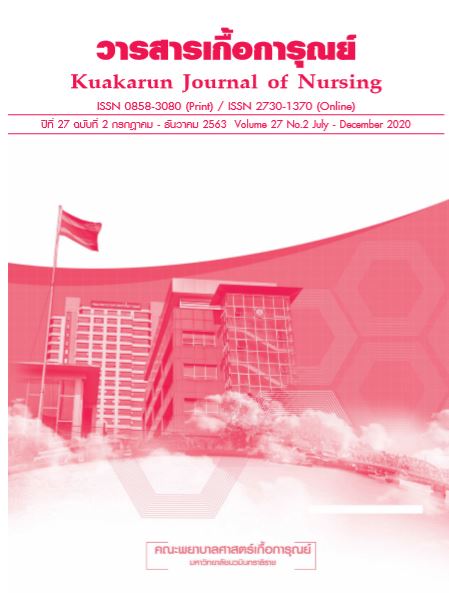การถูกกระทำความรุนแรงต่อคนพิการทางการเคลื่อนไหวหรือทางร่างกาย และปัจจัยที่เกี่ยวข้องในจังหวัดสมุทรปราการ
คำสำคัญ:
คนพิการทางการเคลื่อนไหว, คนพิการทางร่างกาย, ความรุนแรงต่อคนพิการบทคัดย่อ
การวิจัยเชิงพรรณนานี้มีวัตถุประสงค์ เพื่อศึกษาความชุกของการถูกกระทำความรุนแรงของคนพิการทางการเคลื่อนไหวหรือทางร่างกาย และปัจจัยที่เกี่ยวกับการถูกกระทำความรุนแรง โดยประยุกต์ใช้แนวคิดทฤษฎีระบบนิเวศวิทยาขององค์การอนามัยโลก ค.ศ. 2014 มาเป็นกรอบแนวคิดการวิจัย กลุ่มตัวอย่าง คือ คนพิการทางการเคลื่อนไหวหรือทางร่างกาย อายุตั้งแต่ 20 ปีขึ้นไป ได้ขนาดตัวอย่าง 201 คน ได้จากการสุ่มตัวอย่างแบบไม่ใส่คืน เครื่องมือที่ใช้ในการวิจัยคือ แบบสอบถามจำนวน 6 ชุด และในเนื้อหาเป็น 7 ชุด มีค่าดัชนีความตรงตามเนื้อหาอยู่ระหว่าง .89 – 1.00 มีค่าความเชื่อมั่นอยู่ระหว่าง .72 – 1.00 วิเคราะห์ข้อมูลด้วยสถิติเชิงพรรณนา และสถิติไคสแควร์
ผลการศึกษาพบว่า กลุ่มตัวอย่างเคยถูกกระทำความรุนแรงโดยรวมร้อยละ 98 โดยเคยถูกกระทำความรุนแรงด้านจิตใจ ร้อยละ 96.50 ด้านร่างกาย ร้อยละ 77.10 ด้านการถูกทอดทิ้ง ร้อยละ 76.50 และด้านทางเพศร้อยละ 36.30 ตามลำดับ ผลวิเคราะห์พบว่า ความสัมพันธ์ระหว่างปัจจัยที่เกี่ยวข้องกับการถูกกระทำความรุนแรงด้านร่างกาย ได้แก่ อายุ สภาวะการเจ็บป่วย และสัมพันธภาพในครอบครัว ส่วนความสัมพันธ์กับการถูกกระทำความรุนแรงด้านจิตใจ ได้แก่ รายได้ สภาวะการเจ็บป่วย และสัมพันธภาพในครอบครัว ด้านความสัมพันธ์กับการถูกกระทำความรุนแรงด้านทางเพศ ได้แก่ เพศ รายได้ การรับรู้การถูกกระทำความรุนแรง สัมพันธภาพในครอบครัว และค่านิยมที่เกี่ยวกับความรุนแรง ด้านความสัมพันธ์กับการถูกกระทำความรุนแรงด้านการถูกทอดทิ้ง ได้แก่ รายได้ ลักษณะความพิการ และสัมพันธภาพในครอบครัว ข้อเสนอแนะคือ ผู้สนใจสามารถนำไปใช้เป็นแนวทางการจัดโปรแกรมเพื่อส่งเสริม และป้องกันการถูกกระทำความรุนแรงที่จะเกิดขึ้นกับคนพิการทางการเคลื่อนไหวหรือทางร่างกายได้
เอกสารอ้างอิง
World Health Organization. Global status report on violence prevention 2014. Switzerland, Geneva: World Health Organization; 2014.
Department of Promotion and Development of the Quality of Life of Persons with Disabilities. Ministry of Social Development and Human Security, 2017 [Internet]. 2017 [cited 2017 Jan 5]. Available from: http://dep.go.th/Content/View/4199/1 (in Thai)
Social Assistance Center. Results of the overall violence survey in 76 provinces of Thailand in 2013 [Internet]. 2013 [cited 2017 Jan 7]. Available from: https://www.m-society.go.th/ewtadmin/ewt/mso_web/article_attach/14400/15717.pdf (inThai)
Khalifeh H, Howard LM, Osborn D, Moran P, Johnson S. Violence against people with disability in England and Wales: findings from a national cross-sectional survey. PLOS One 2013;8(2):e55952.
Smith DL. Disability, gender and intimate partner violence: relationships from the behavioral risk factor surveillance system. Sexuality and Disability 2008;26(1):15-28.
Mitra M, Mouradian VE, Diamond M. Sexual violence victimization against men with disabilities. American journal of preventive medicine 2011;41(5):494-7.
Perreault S. Criminal victimization and health: a profile of victimization among persons with activity limitations or other health problems. Ottawa: Canadian Centre for Justice Statistics; 2009.
Puri M, Misra G, Hawkes S. Hidden voices: prevalence and risk factors for violence against women with disabilities in Nepal. BMC Public Health 2015;15:261.
Krnjacki L, Emerson E, Llewellyn G, Kavanagh AM. Prevalence and risk of violence against people with and without disabilities: findings from an Australian population based study. Australian and New Zealand Journal of Public Health 2016;40(1):16-21.
Chuaykamchoo A. Domestic violence: causes, impacts, and help methods. Journal of Thammasat University 2012;31(3):130-45. (in Thai)
Thananowan N. Violence: analysis and conclusion from nursing evidence. Bangkok: Wee print company (1991); 2014. (in Thai)
Chiangkhong A. Factors related to workplace violence among nurse in factories [Dissertation]. Bangkok: Mahidol University; 2011. (in Thai)
Srivilai V. The factors related to violence against the eldely in Danchang District, Suphanburi Province [Dissertation]. Bangkok: Mahidol University; 2011. (in Thai)
Daniel WW. Biostatistics, student solutions manual: a foundation for analysis in the health sciences. Hoboken, NJ: Wiley; 2009.
Ministry of Public Health. Caring for the 4 main problems of Social Support Center : the assess and rehab for health personnel, health promoting hospital. 1st ed. Nonthaburi : The Agricultural Cooperative Federation of Thailand; 2013. (in Thai)















